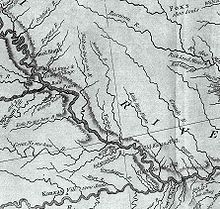|
Nishnabotna River
  The Nishnabotna River (/nɪʃnəˈbɑːtnə/) is a tributary of the Missouri River in southwestern Iowa, northwestern Missouri and southeastern Nebraska in the United States. It flows for most of its length as two parallel streams in Iowa, the East Nishnabotna River and the West Nishnabotna River. The east and west branches are each about 120 miles (190 km) long; from their confluence the Nishnabotna flows approximately another 16 miles (26 km).[1] Several sections of the rivers' courses have been straightened and heavily channelized. In March 2024 a fertilizer spill killed much of the aquatic life across a 60-mile stretch of the Nishnabotna river in Iowa and Missouri, leaving an estimated 789,000 fish dead in one of the region’s most ecologically devastating chemical spills on record. The source of the spill originated when a valve was left open on a storage tank over the weekend of March 9-11 at NEW Cooperative, an agricultural business in Red Oak, Iowa. The leak drained approximately 265,000 gallons of liquid nitrogen fertilizer into the nearby East Nishnabotna River.[2][3] Traditionally, it has been assumed that the name "Nishnabotna" comes from an Otoe (Chiwere) word meaning "canoe-making river."[4] However, it has been proposed more recently that the name comes from the Osage language and means "spouting wellspring."[5] CourseEast Nishnabotna River The East Nishnabotna rises in southwestern Carroll County and flows generally south-southwestwardly through Audubon, Cass, Pottawattamie, Montgomery, Page and Fremont Counties, past the towns of Exira, Brayton, Atlantic, Lewis, Elliott, Shenandoah, Red Oak and Riverton. At Red Oak, the river's average discharge is 506 cubic feet per second.[6] West Nishnabotna RiverThe West Nishnabotna River rises in southwestern Carroll County and also flows generally south-southwestwardly through Crawford, Shelby, Pottawattamie, Mills and Fremont Counties, past the towns of Manning, Irwin, Kirkman, Harlan, Avoca, Hancock, Oakland and Carson. At Harlan it collects the West Fork West Nishnabotna River, which rises in southwestern Carroll County and flows southwestwardly through Crawford and Shelby Counties, past Manilla and Defiance. Near Avoca it collects the East Branch West Nishnabotna River, which rises in southwestern Carroll County and flows southwestwardly through Audubon, Shelby and Pottawattamie Counties. The West Nishnabotna was the topic of a humorous song "Four Wheel Drive" on the 1975 C.W. McCall album Wolf Creek Pass. At Randolph, Iowa, the river averages 747 cubic feet per second.[7] Lower river The East and West rivers merge in southwestern Fremont County and continue as the Nishnabotna River for its short course past Hamburg and into northwestern Atchison County, Missouri, where it flows into the Missouri River 2 mi (3 km) west of Watson. In the last mile of the river it flows from Missouri to Nebraska and back to Missouri before entering the Missouri river in west central Atchison County, MO. This is because an 1867 flood straightened a bend in the Missouri and caused the Nishnabotna to flow about two miles further to reach the Missouri. The Nishnabotna forms roughly the southeastern border of the 5,000 acre McKissick Island which was the land Nebraska and Missouri both claimed. The Supreme Court in 1904 officially drew the border with Nebraska getting the land although it is east of Nebraska's normal eastern border which is the river.[8][9][10] At Hamburg, the river has a mean annual discharge of 1,441 cubic feet per second.[11] RecreationParks along the river include Botna Bend in Hancock, Willow Slough Wildlife Management Area 3 miles southwest of Henderson, and Riverton Wildlife Management Area, just north of Riverton. Canoe rentals are available at Botna Bend. The best paddling is between Hancock and Carson on the west fork and between Lewis and Griswold on the east fork (see "Paddling Iowa" by Nate Hoogeveen). The Wabash Trace Nature Trail crosses both forks. At its crossing of the west fork one can see the wreckage of a freight train that derailed and went into the drink in the 1960s. Variant namesAccording to the Geographic Names Information System, the river has also been known as:[12]
Other literature sources[13] cite many of the above name in addition to:
See alsoReferences
|